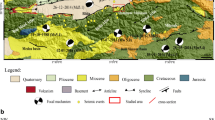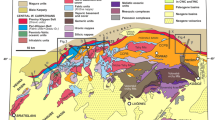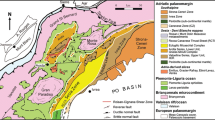Abstract
The Woodlark triple junction region, a topographically and structurally complex triangular area of Quaternary age, lies east of Simbo Ridge and southwest of the New Georgia island group, Solomon Islands, at the junction of the Pacific, Australian and Solomon Sea plates. SeaMARC II side-scan imagery and bathymetry in conjunction with seismic reflection profiles, 3.5 kHz records, and petrologic, magnetic and gravity data show that the active Woodlark spreading centre does not extend into this region.
South of the triple junction region, the Woodlark spreading centre reoriented at about 2 Ma into a series of short ESE-trending segments. These segments continued to spread until about 0.5 Ma, when the lithosphere on their northern sides was transferred from the Solomon Sea plate to the Australian plate. Simultaneously the Simbo transform propagated northwards along the western side of the transferred lithosphere, forming a trench-trench-transform triple junction located NNW of Simbo island and a new leaky plate boundary segment that built Simbo Ridge.
As the Pacific plate approached, the area east of northern Simbo Ridge was tilted northwards, sheared by dominantly right-lateral faults, elevated, and intruded by arc-related magmas to form Ghizo Ridge. Calc-alkalic magmas sourced beneath the Pacific plate built three large strato-volcanic edifices on the subducting Australian plate: Simbo at the northern end of Simbo Ridge, and Kana Keoki and Coleman seamounts on an extensional fracture adjoining the SE end of Ghizo Ridge.
A sediment drape, supplied in part from Simbo and Kana Keoki volcanoes, mantles the east-facing slopes of northern Simbo and Ghizo Ridges and passes distally into sediment ponded in the trench adjoining the Pacific plate. As a consequence of plate convergence, parts of the sediment drape and pond are presently being deformed, and faults are dismembering Kana Keoki and Coleman seamounts.
The Woodlark system differs from other modern or Tertiary ridge subduction systems, which show wide variation in character and behaviour. Existing models describing the consequences of ridge subduction are likely to be predictive in only a general way, and deduced rules for the behaviour of oceanic lithosphere in ridge subduction systems may not be generally applicable.
Similar content being viewed by others
References
Barker, P. F., 1982, The Cenozoic Subduction History of the Pacific Margin of the Antarctic Peninsula: Ridge Crest-Trench Interactions,J. Geol. Soc. London 139, 787–801.
Barker, P. F., Barber, P. L., and King, E. C., 1984, An Early Miocene Ridge Crest-Trench Collision on the South Scotia Ridge near 36°W,Tectonophysics 102, 315–332.
Bianchi, R., Casacchia, R., Coradini, A., Duncan, A. M., Guest, J. E., Kahle, A., Lanciano, P., Pieri, D. C., and Poscolieri, M., 1990, Remote Sensing of Italian Volcanoes,Eos, Trans. Amer. Geophys. Un. 71, 1789–1791.
Cande, S. C., Leslie, R. B., Parra, J. C., and Hobart, M., 1987, Interaction between the Chile Ridge and Chile Trench: Geophysical and Geothermal Evidence,J. Geophys. Res. 92, 495–520.
Cas, R. A. F. and Wright, J. V., 1987,Volcanic Successions Modern and Ancient, Allen and Unwin, London, 529 pp.
Coleman, P. J. and Packham, G. H., 1976, The Melanesian Borderlands and the Indian-Pacific Plates' Boundary,Earth-Sci. Reviews 12, 197–233.
Cooper, A. K., Marlow, M. S., and Scholl, D. W., 1976, Mesozoic Magnetic Lineations in the Bering Sea Marginal Basin.J. Geophys. Res. 81, 1916–1934.
Coulbourn, W. T., Hill, P. J., and Bergersen, D. D., 1989, Machias Seamount, Western Samoa: Sediment Remobilization, Tectonic Dismemberment and Subduction of a Guyot,Geo-Marine Lett. 9, 119–125.
Crook, K. A. W., Taylor, B., and Falvey, D. A., 1991, Woodlark Triple Junction, Solomon Islands, SeaMARC II Sidescan Sonar Imagery and Bathymetry, 1:250,000.Pacific Seafloor Atlas, Hawaii Institute of Geophysics, Honolulu HI, Sheet 9.
Crook, K. A. W. and Taylor, G. R., 1987, Sedimentary Petrology and Mineral Chemistry, Woodlark Basin-Solomon Islands Offshore Region,Circum-Pacific Council for Energy and Mineral Resources, Earth Sci. Ser. 7, 295–346.
DeLong, S. E. and Fox, P., 1977, Geological Consequences of Ridge Subduction,in Talwani, M. and Pittman III, W. C. (eds.),Island Arcs, Deep Sea Trenches and Back-Arc Basins, American Geophysical Union, Maurice Ewing Series1, 221–228.
DeLong, S. E., Fox, P., and McDowell, F. W., 1978, Subduction of the Kula Ridge at the Aleutian Trench,Geol. Soc. Amer. Bull. 89, 83–95.
DeLong, S. E., Schwarz, W. M., and Anderson, R. N., 1979, Thermal Effects of Ridge Subduction,Earth Planet. Sci. Lett. 44, 239–246.
Dunkley, P. N. and Philips, P. R., 1986,Rendova and Tetepare Islands, New Georgia Geological Map Sheet NG 6, Geological Survey Division, Honiara, Solomon Islands.
Exon, N. F. and Johnson, R. W., 1986, The Elusive Cook Volcano and Other Submarine Forearc Volcanoes in the Solomon Islands,BMR J. Aust. Geol. Geophys. 10, 77–83.
Exon, N. F. and Johnson, R. W., 1989, Reply: The Elusive Cook Volcano and Other Submarine Forearc Volcanoes in the Solomon Islands,BMR J. Aust. Geol. Geophys. 11, 121.
Forsythe, R. and Nelson, E., 1985, Geological Manifestations of Ridge Collision: Evidence from the Golfo de Penas—Taito Basin, Southern Chile,Tectonics 4, 477–495.
Forsythe, R. D., Diemer, J. A., and Nelson, E., 1990, Stratified Rocks of the Taito Ophiolite, Chile Margin Triple Junction Region: Stratigraphic and Sedimentological Observations,Eos, Trans. Amer. Geophys. Un. 71, 1576.
Forsythe, R. D., Nelson, E. P., Carr, M. J., Kaeding, M. E., Herve, M., Mpodozis, C., Soffia, J. M., and Harambour, S., 1986, Pliocene Near-Trench Magmatism in Southern Chile: A Possible Manifestation of Ridge Collision,Geology 14, 23–27.
Grover, J. C., 1958, The Solomon Islands — Geological Exploration and Research, 1953–1956,Mem. Geol. Surv. Br. Solomon Islands 2, 151pp.
Hall, L. H., 1989, Discussion: The Elusive Cook Volcano and Other Submarine Forearc Volcanoes in the Solomon Islands,BMR J. Aust. Geol. Geophys. 11, 119–120.
Hibbard, J. P. and Karig, D. E., 1990a, Alternative Plate Model for the Early Miocene Evolution of the Southwest Japan Margin,Geology 18, 170–174.
Hibbard, J. P. and Karig, D. E., 1990b, Structural and Magmatic Responses to Spreading Ridge Subduction: An Example from Southwest Japan,Tectonics 9, 207–230.
Johnson, R. W., Jaques, A. L., Langmuir, C. H., Perfit, M. R., Staudigel, H., Dunkley, P. N., Chappell, B. W., Taylor, S. R., and Baekisapa, M., 1987, Ridge Subduction and Forearc Volcanism: Petrology and Geochemistry of Rocks Dredged from the Western Solomon Arc and Woodlark Basin,Circum-Pacific Council for Energy and Mineral Resources, Earth Sci. Ser. 7, 155–226.
Johnson, R. W. and Molnar, P., 1972, Focal Mechanisms and Plate Tectonics of the Southwest Pacific,J. Geophys. Res. 77, 5000–5032.
Johnson, R. W. and Tuni, D., 1987, Kavachi, an Active Forearc Volcano in the Western Solomon Islands: Reported Eruptions between 1950 and 1982,Circum-Pacific for Energy and Mineral Resources, Earth Sci. Ser. 7, 89–112.
Krause, D. C., 1973, Crustal Plates of the Bismarck and Solomon Seas,in Fraser, R. (compiler),Oceanography of the South Pacific 1972, Wellington, New Zealand National Commission for UNESCO. 271–280.
Lister, C. R. B., 1989, Plate Tectonics at an Awkward Junction: Rules for the Evolution of Sovanco Ridge Area, NE Pacific,Geophys. J. 96, 191–201.
Luyendyk, B. P., MacDonald, K. C., and Bryan, W. B., 1973, Rifting History of the Woodlark Basin in the Southwest Pacific,Geol. Soc. Amer. Bull. 84, 1125–1134.
Marshak, R. S. and Karig, D. E., 1977, Triple Junctions as a Cause for Anomalously Near-Trench Igneous Activity between the Trench and Volcanic Arc,Geology 5, 233–236.
Menard, H. W., 1978, Fragmentation of the Farallon Plate by Pivoting Subduction,J. Geol. 86, 99–1110.
Milsom, J., Masson, D., Nichols, G., Sikumbang, N., Bwiyanto, B., Parson, L., and Kallagher, H., 1992, The Manokwari Trough and the Western End of the New Guinea Trench,Tectonics 11, 145–153.
Nakamura, K., 1977, Volcanoes as Possible Indicators of Tectonic Stress Orientation — Principle and Proposal,J. Volcanism Geothermal Res. 2, 1–16.
Perfit, M. R., Langmuir, C. H., Baekisapa, M., Chappell, B., Johnson, R. W., Staudigel, H., and Taylor, S. R., 1987, Geochemistry and Petrology of Volcanic Rocks from the Woodlark Basin: Addressing Questions of Ridge Subduction,Circum-Pacific Council for Energy and Mineral Resources, Earth Sci. Ser. 7, 113–154.
Taylor, B., 1987, A Geophysical Survey of the Woodlark-Solomons Region,Circum-Pacific Council for Energy and Mineral Resources, Earth Sci. Ser. 7, 25–48.
Taylor, B. and Exon, N. F. (eds)., 1987, Marine Geology, Geophysics, and Geochemistry of the Woodlark Basin-Solomon Islands,Circum-Pacific Council for Energy and Mineral Resources, Earth Sci. Ser. 7, 361pp.
Taylor, B. and Exon, N. F., 1987, An Investigation of Ridge Subduction in the Woodlark-Solomons Region: Introduction and Overview,Circum-Pacific Council for Energy and Mineral Resources, Earth Sci. Ser. 7, 1–24.
Taylor, B. and Karner, G. D., 1983, On the Evolution of Marginal Basins,Rev. Geophys. Space Phys. 21, 1727–1741.
Tiffin, D. L., Taylor, B., Crook, K. A. W., Sinton, J., and Frankel, E., 1986, Surveys in the Solomon Islands and Papua New Guinea Using SeaMARC II,CCOP/SOPAC Cruise Report 117, 25pp.
Weissel, J. K., Taylor, B., and Karner, G. D., 1982, The Opening of the Woodlark Basin, Subduction of the Woodlark Spreading System, and the Evolution of Northern Melanesia since Mid-Pliocene Time,Tectonophysics 87, 253–278.
Author information
Authors and Affiliations
Rights and permissions
About this article
Cite this article
Crook, K.A.W., Taylor, B. Structure and Quaternary tectonic history of the Woodlark triple junction region, Solomon Islands. Mar Geophys Res 16, 65–89 (1994). https://doi.org/10.1007/BF01812446
Received:
Revised:
Issue Date:
DOI: https://doi.org/10.1007/BF01812446




